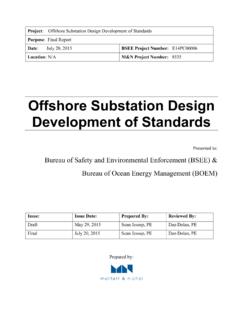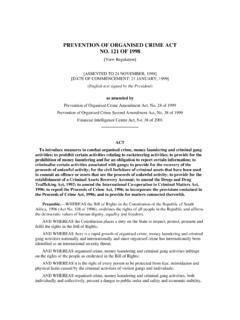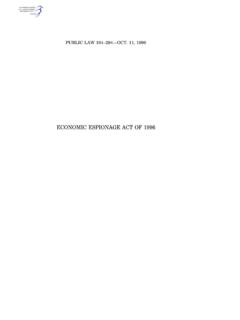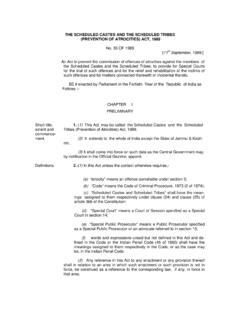Transcription of The Clean Air Act of 1963 - Bureau of Ocean Energy …
1 1 The Clean Air Act of 1963 The Clean Air Act of 1963, 42 7401, is a federal law designed to control air pollution on a national level. It is one of the United States' first and most influential modern environmental laws, and one of the most comprehensive air quality laws in the world. As with many other major federal environmental statutes, it is administered by the Environmental Protection Agency (EPA), in coordination with state, local, and tribal governments. Its implementing regulations are codified at 40 Sub-chapter C, Parts 50 97. The 1955 Air Pollution Control Act was the first federal legislation that pertained to air pollution; it also provided funds for federal government research of air pollution. The first federal legislation to pertain to "controlling" air pollution was the Clean Air Act of 1963. The 1963 act accomplished this by establishing a federal program within the Public Health Service and authorizing research into techniques for monitoring and controlling air pollution.
2 It was first amended in 1965, by the Motor Vehicle Air Pollution Control Act, which authorized the federal government to set required standards for controlling the emission of pollutants from certain automobiles, beginning with the 1968 models. A second amendment, the Air Quality Act of 1967, enabled the federal government to increase its activities to investigate enforcing interstate air pollution transport, and, for the first time, to perform far-reaching ambient monitoring studies and stationary source inspections. The 1967 act also authorized expanded studies of air pollutant emission inventories, ambient monitoring techniques, and control techniques. Further amendments were made in 1990 to address the problems of acid rain, ozone depletion, and toxic air pollution, and to establish a national permit program for stationary sources, and increased enforcement authority.
3 The amendments also established new auto gasoline reformulation requirements, set Reid vapor pressure (RVP) standards to control Evaporative emissions from gasoline, and mandated new gasoline formulations sold from May to September in many states. The Clean Air Act was the first major environmental law in the United States to include a provision for citizen suits. Numerous state and local governments have enacted similar legislation, either implementing federal programs or filling in locally important gaps in federal programs. The Clean Air Act consists of six sections called Titles. The first title, Title I, is the one that most closely relates to BOEM s programs, since BOEM is mandated by the Outer Continental Shelf Lands Act (OCSLA) to ensure that activities which it approves on the OCS do not cause a significant adverse to the coastal States, such that their air quality would no longer comply with the primary and secondary National Ambient Air Quality Standards (NAAQS).
4 Title I: Programs and Activities The first Title declares that protecting and enhancing the nation's air quality promotes public health. The law encourages to prevent regional air pollution and control programs. It also provides technical and financial assistance for preventing air pollution at both state and local 2 governments. Additional sub chapters cover cooperation, research, investigation, training, and other activities. The CAA mandates that the EPA create air quality control regions, designated as attainment vs non-attainment. Non-attainment areas do not meet national standards for primary or secondary ambient air quality. Attainment areas meet these standards, while unclassified areas cannot be classified based on the available information. Air quality criteria, national primary and secondary ambient air quality standards, state implementation plans and performance standards for new stationary sources are covered in Part A of Title I, as well.
5 The list of hazardous air pollutants that the act establishes includes compounds of Acetaldehyde, benzene, chloroform, Phenol, and selenium. The list also includes mineral fiber emissions from manufacturing or processing glass, rock or slag fibers as well as radioactive atoms. The list can periodically be modified. The remaining sub-chapters cover smokestack heights, state plan adequacy, and estimating emissions of carbon monoxide, volatile organic compounds, and oxides of nitrogen from area and mobile sources. Measures to prevent unemployment or other economic disruption include using local coal or coal derivatives to comply with implementation requirements. The final sub chapter in this act focuses on land use authority. Title I, Part C : Prevention of Significant Deterioration of Air Quality The Clean Air Act requires permits to build or add to major stationary sources of air pollution.
6 This permitting process, known as New Source Review (NSR), applies to sources in areas that meet air quality standards as well as areas that are unclassified. Permits in attainment or unclassified areas are referred to as Prevention of Significant Deterioration (PSD) permits, while permits for sources located in nonattainment areas are referred to as non-attainment area (NAA) permits. The fundamental goals of the PSD program are to: new non-attainment areas by ensuring economic growth in harmony with existing Clean air; public health and welfare from any adverse effects; and enhance the air quality in national parks and other areas of special natural recreational, scenic, or historic value. Part D: Plan Requirements for Non-attainment Areas Under the Clean Air Act states are required to submit a plan for non-attainment areas to reach attainment status as soon as possible but in no more than five years, based on the severity of the air pollution and the difficulty posed by obtaining cleaner air.
7 The plan must be approved or revised if required for approval, and specify whether local governments or the state will implement and enforce the various changes. Achieving attainment 3 status makes a request for reevaluation possible. It must include a plan for maintenance of air quality. Title II contains emission standards for moving sources. Title III: General Provisions Under the law prior to 1990, EPA was required to construct a list of Hazardous Air Pollutants as well as health-based standards for each one. There were 187 air pollutants listed and the source from which they came. The EPA was given ten years to generate technology-based emission standards. Title III is considered a second phase, allowing the EPA to assess lingering risks after the enactment of the first phase of emission standards. Title III also enacts new standards with regard to the protection of public health.
8 A citizen may file a lawsuit to obtain compliance with an emission standard issued by the EPA or by a state, unless there is an ongoing enforcement action being pursued by EPA or the appropriate state agency. Title IV: Noise Pollution This title established the EPA Office of Noise Abatement and Control to reduce noise pollution in urban areas, to minimize noise-related impacts on psychological and physiological effects on humans, effects on wildlife and property (including values), and other noise-related issues. The agency was also assigned to run experiments to study the effects of noise. Title IV-A: Acid Deposition Control This title was added as part of the 1990 amendments. It addresses the issue of acid rain, which is caused by nitrogen oxides (NOx ) and sulfur dioxide (SO2) emissions from electric power plants powered by fossil fuels, and other industrial sources.
9 The 1990 amendments gave industries more pollution control options including switching to low-sulfur coal and/or adding devices that controlled the harmful emissions. In some cases, plants had to be closed down to prevent the dangerous chemicals from entering the atmosphere. Title IV-A mandated a two-step process to reduce SO2 emissions. The first stage required more than 100 electric generating facilities larger than 100 megawatts to meet a million ton SO2 emission reduction by January 1995. The second stage gave facilities larger than 75 megawatts a January 2000 deadline. Title V: Permits The 1990 amendments authorized a national operating permit program, covering thousands of large industrial and commercial sources. It required large businesses to address pollutants released into the air, measure their quantity, and have a plan to control and minimize them as well as to periodically report.
10 This consolidated requirements for a facility into a single document. In non-attainment areas, permits were required for sources that emit as little as 50, 25, or 10 tons per year of VOCs depending on the severity of the region's non-attainment status. 4 Most permits are issued by state and local agencies. If the state does not adequately monitor requirements, the EPA may take control. The public may request to view the permits by contacting the EPA. The permit is limited to no more than five years and requires a renewal. Title VI: Stratospheric Ozone Protection Starting in 1990, Title VI mandated regulations regarding the use and production of chemicals that harm the Earth's stratospheric ozone layer. This ozone layer protects against harmful ultraviolet B sunlight linked to several medical conditions including cataracts and skin cancer.











